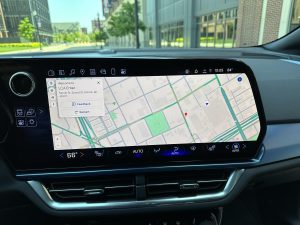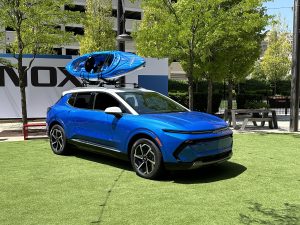Today’s cars are designed to pair up with personal devices, such as smartphones, typically through Apple CarPlay and Android Auto. But some automakers, notably General Motors, are dropping those features in favor of “native,” or built-in, systems. They do so at their own peril, according to a new survey showing a third of new vehicle buyers won’t buy such vehicles.

The Chevrolet Equinox EV does not offer either Apple CarPlay or Android Auto – and GM is phasing it out on all of its EVs.
When the new Chevrolet Equinox EV starts rolling into showrooms buyers may be in for a surprise. While it has a sophisticated new infotainment system the battery-electric vehicle is missing two features that have become all but ubiquitous in today’s new products: Apple CarPlay and Android Auto.
Parent General Motors is phasing out those two functions in favor of an in-house system that it claims to be better at linking vehicles with smartphones. And it’s not the only automaker taking that approach. Neither CarPlay nor Android Auto are available in Tesla and Rivian vehicles, while other companies hint they could follow suit.
But that’s a risky move, according to a new consumer survey from McKinsey & Co. It found roughly a third of potential car buyers saying they won’t buy a car without those features.
Smart links

Most manufacturers – such as Mitsubishi – now offer both Apple CarPlay and Android Auto, increasingly in wireless form.
About 92% of Americans now own at least one smartphone, according to Pew Research. They’ve not just become commonplace but are ubiquitous, most owners carrying them everywhere they go and using them for everything from access to news and social media to operate smart home devices, such as lights and garage doors. Occasionally, they’re even used as phones.
CarPlay and Android Auto are designed to let a car’s infotainment system mirror what’s on a smartphone’s screen. Commonly, that integrates the cellular device’s phone and navigation functions, as well as a variety of other apps. That’s particularly useful, many drivers have found, when a vehicle doesn’t have an integrated navi system. Even if it does, prior surveys have shown, many drivers prefer to use the mapping capabilities in their smartphones.
As a result, almost all manufacturers have added Apple CarPlay and Android Auto functionality to their latest products. But GM, one of the earliest adopters, is reversing course. The reason is simple, several of the automaker’s technology experts told Headlight.News. They think they can better integrate functions like navi and streaming audio by building them directly into a vehicle’s native operating system. This, they claim, makes it easier to display charging locations for an EV, or to integrate navigation-based information into the automaker’s hands-free Super Cruise system.
A questionable decision

GM is betting its native infotainment system has better features than either Apple CarPlay or Android Auto – and the Equinox EV will test whether it can convince buyers.
GM announced its new strategy last December and has begun phasing out CarPlay and Android Auto on the new EVs it’s introducing this year, such as the Equinox EV and Cadillac Optiq – though those functions are still available in the older Caddy Lyriq. GM is expected to follow with a phase-out on vehicles with internal combustion engines, as well.
But it’s doing so at its own peril, Kevin Laczkowski, global co-lead of McKinsey’s automotive and assembly practice, said during a media webinar. “If an OEM moves away from seamless smartphone integration, obviously that’s a risk.”
Its new study found fully 30% of EV buyers and 35% of buyers shopping for a vehicle with an internal combustion engine saying they will skip any product lacking Apple CarPlay or Android Auto.
More Technology News
- Charger Cable Thefts Become Latest Obstacle to EV Adoption
- Half of American Motorists Want Feature to Prevent Vehicles from Speeding
- Faulty Rearview Cameras Force Stellantis to Recall Over 1 Mil Vehicles
Naysayers
Tesla has so far rejected both of those smartphone integration functions. So has Rivian, though the latter acknowledged that it initially got pushback from 70% of potential buyers. Even after showing how its native system performed similar functions, 30% of those shoppers still rejected the automaker, according to a report by Bloomberg.
If anything, some automakers are going out of their way to reassure motorists those Apple and Android features won’t be dropped. Even as Ford upgrades its Sync infotainment system to integrate the Google built-in technology, it will continue to offer CarPlay and Android Auto, CEO Jim Farley recently announced. The same goes with Toyota and Mercedes-Benz, both of which have developed their own voice assistants.
In some cases, manufacturers are giving motorists an expanding list of options; they’ll be able to work with a native voice system, Apple CarPlay or Android Auto, and even Amazon’s Alexa, the most popular of the home automation technologies.
The Feds weigh in
GM, Tesla and Rivian aren’t the only skeptics when it comes to Apple CarPlay, reported Automotive News.
Like General Motors, Apple aims to more fully integrate CarPlay into the vehicle’s digital functionality. An upcoming update will allow the system to spread out onto other screens within a vehicle. That could include the gauge cluster and even a head-up display, as well as passenger displays used for in-vehicle entertainment.
That poses the possibility of creating an “iPhone-centric experience,” the U.S. Department of Justice claimed in an antitrust complaint filed in March against Apple.
That could be a bigger risk than GM’s move to phase out CarPlay. But, for the moment, the upgraded Apple system appears to be gaining traction, automakers including Aston Martin and Porsche signing on to adopt the revised feature.


I used to own a GMC Denali pickup that had (wired) Android Auto. I never used it. We recently rented a Land Rover Defender for a week. It had Android Auto (wireless). I was pretty excited about that, until my phone connected and I could no longer seem to control anything else in the car. For example the radio was playing, but all I could see was my phone screen. I then figured out how to tell the onboard system not to use Android Auto. Part of the problem may have been that the Defender seemed pretty complicated to use (I had to read the owner’s manual twice to figure out the cruise control), but overall, I think I’d rather have one system running than two.
Infotainment System / Touch Screen = No Sale in my opinion. Give me another option. Also, bring back the Manual Parking Break, The Key. Eliminating the Physical Security is a large step backwards. A Keyed Door Lock and Ignition or start is a must. I would like physical buttons, switches, dials, and knobs. A Manual Transmission Option would be appropriated as well. Basic Reliable dependable is what I want. The more bells and whistles that are in a Vehicle or system. The more there is to break.
The Infotainment System opens the door for Hackers, Auto Thieves, Increases Auto Complexity, Cost to Repair, is a Data Privacy Nightmare, a Distraction and a Saftey Issue. I say no Thank you, give me a option to opt out of the Infotainment System / Screens. This includes the Digital Instrument Cluster as well. Simple, Reliable, Dependable, Rugged is what I am looking for.
Do consider this: it was the lack of digital ignition technology that made so many Hyundai and Kia products easy targets for car thieves.
Paul E.
Infotainment System in a Vehicle = No Sale. Give me an Option to Opt Out of the Infotainment System and the other distracting things like Digital instrument cluster that displays non relevant distracting information to the Driver. Using a Cell Phone while Driving is not allowed. Some how the use of a Infotainment system is allowed. What is going on. Distracted Driving is Dangerous Driving.